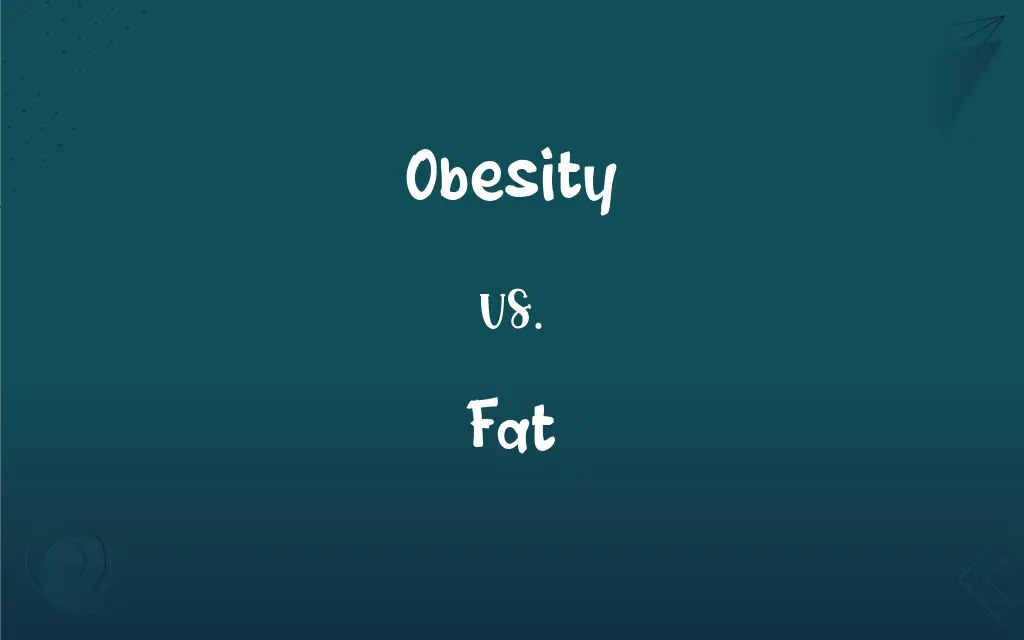Obesity vs. Fat: What's the Difference?
Edited by Aimie Carlson || By Janet White || Published on January 2, 2024
Obesity is a medical condition characterized by excessive body fat, while fat is a natural substance in the body, used for energy and other functions.

Key Differences
Obesity is a health condition defined by an excess amount of body fat that poses risks to health. It is typically measured using the body mass index (BMI), where a BMI of 30 or more is considered obese. Fat, in contrast, is a basic component of the body, serving as an energy store, insulator, and cushion for organs. While everyone has some body fat, the amount and distribution of fat can vary significantly.
The term obesity implies a certain level of health risk due to excessive fat accumulation. It is often associated with increased risks of diseases like diabetes, heart disease, and certain cancers. Fat itself is a neutral term, simply describing one of the macronutrients in food and a constituent of the human body. It plays vital roles in hormone production, nutrient absorption, and body temperature regulation.
Obesity is a clinical diagnosis often requiring medical intervention, while fat is a normal and essential part of the human body. The management of obesity usually involves lifestyle changes such as diet and exercise, medical treatment, or surgery. On the other hand, managing body fat is often about balance – ensuring enough fat for bodily functions without excessive accumulation.
Obesity is often visible as it alters an individual's body shape and can affect mobility and physical comfort. Fat, however, can be both visible and invisible, as it is distributed throughout the body, including around vital organs. Not all people with a higher amount of body fat are obese; it depends on the proportion of fat to muscle and overall body composition.
Obesity is a medical condition resulting from excessive fat accumulation, posing health risks. Fat itself is a necessary and natural part of the human body, important for various physiological functions. The distinction between obesity and fat is crucial for understanding health risks and the body's normal functions.
ADVERTISEMENT
Comparison Chart
Definition
A medical condition with excessive body fat
A natural substance in the body used for energy and other functions
Measurement
Measured by BMI, waist circumference, etc.
Measured in terms of percentage of body weight
Health Implications
Linked with increased health risks like heart disease
Essential for bodily functions but excessive amount is unhealthy
Management
Requires lifestyle changes, medical intervention
Managed through balanced diet and exercise
Visibility
Often visibly alters body shape
Can be both visible and stored internally
ADVERTISEMENT
Obesity and Fat Definitions
Obesity
Clinically defined by a BMI of 30 or above.
His doctor diagnosed him with obesity after calculating his BMI.
Fat
A substance in the body that cushions organs.
Body fat helps to protect our internal organs from injury.
Obesity
A condition of having an excessive amount of body fat.
Obesity rates have risen globally, prompting public health concerns.
Fat
A macronutrient important for energy storage.
Avocados are a good source of healthy fat.
Obesity
Associated with increased health risks.
Obesity is a risk factor for type 2 diabetes and heart disease.
Fat
Essential for hormone production and nutrient absorption.
Dietary fat is crucial for absorbing vitamins A, D, E, and K.
Obesity
Often results from an energy imbalance.
Sedentary lifestyles contribute to the prevalence of obesity.
Fat
Can be saturated or unsaturated in dietary terms.
Olive oil is high in unsaturated fat, beneficial for heart health.
Obesity
A preventable and treatable condition.
Through diet and exercise, she successfully overcame obesity.
Fat
Visible under the skin and around organs.
Visceral fat, stored around organs, is more harmful than subcutaneous fat.
Obesity
The condition of being obese; increased body weight caused by excessive accumulation of fat.
Fat
The ester of glycerol and one, two, or three fatty acids.
Obesity
(pathology) The state of being obese due to an excess of body fat.
Fat
Any of various soft, solid, or semisolid organic compounds constituting the esters of glycerol and fatty acids and their associated organic groups.
Obesity
The state or quality of being obese; excessive body weight; incumbrance of flesh.
Obesity
More than average fatness
FAQs
What is obesity?
A medical condition characterized by excessive body fat.
Can someone be overweight but not obese?
Yes, depending on body composition and fat distribution.
What is fat in the human body?
A natural substance used for energy, insulation, and protection.
What are the types of dietary fat?
Saturated, unsaturated, trans, and omega fatty acids.
Is all body fat harmful?
No, the body needs a certain amount of fat for health.
Does obesity always mean poor health?
Not always, but it increases the risk of various health issues.
How is obesity diagnosed?
Through BMI, waist circumference, and other health assessments.
Is fat necessary in the diet?
Yes, it's essential for various bodily functions.
Can obesity be genetic?
Genetics can play a role, but lifestyle factors are crucial.
What causes obesity?
Often caused by an energy imbalance, genetics, and lifestyle factors.
Does more body fat always mean obesity?
Not necessarily; it depends on overall health and body composition.
Is obesity only related to diet?
Diet is a major factor, but not the only one.
How can you reduce body fat?
Through a balanced diet and regular exercise.
Are there different kinds of body fat?
Yes, such as visceral fat (around organs) and subcutaneous fat (under the skin).
Can obesity be cured?
It can be managed and often reversed with lifestyle changes.
What is the role of fat in the body?
It provides energy, protects organs, and aids in hormone production.
Can thin people have high body fat percentages?
Yes, in cases of low muscle mass and high fat percentage, known as "skinny fat."
Is fat only found under the skin?
No, it's also stored around organs and in muscles.
How do you measure body fat percentage?
Through methods like bioelectrical impedance analysis or skinfold measurements.
What are the health risks of obesity?
Increased risk of diabetes, heart disease, and certain cancers.
About Author
Written by
Janet WhiteJanet White has been an esteemed writer and blogger for Difference Wiki. Holding a Master's degree in Science and Medical Journalism from the prestigious Boston University, she has consistently demonstrated her expertise and passion for her field. When she's not immersed in her work, Janet relishes her time exercising, delving into a good book, and cherishing moments with friends and family.
Edited by
Aimie CarlsonAimie Carlson, holding a master's degree in English literature, is a fervent English language enthusiast. She lends her writing talents to Difference Wiki, a prominent website that specializes in comparisons, offering readers insightful analyses that both captivate and inform.







































































